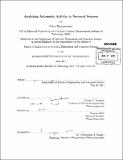| dc.contributor.advisor | George C. Verghese and Thomas Heldt. | en_US |
| dc.contributor.author | Ramaswamy, Priya, M. Eng. Massachusetts Institute of Technology | en_US |
| dc.contributor.other | Massachusetts Institute of Technology. Dept. of Electrical Engineering and Computer Science. | en_US |
| dc.date.accessioned | 2011-11-01T19:46:58Z | |
| dc.date.available | 2011-11-01T19:46:58Z | |
| dc.date.copyright | 2011 | en_US |
| dc.date.issued | 2011 | en_US |
| dc.identifier.uri | http://hdl.handle.net/1721.1/66805 | |
| dc.description | Thesis (M. Eng.)--Massachusetts Institute of Technology, Dept. of Electrical Engineering and Computer Science, 2011. | en_US |
| dc.description | Cataloged from PDF version of thesis. | en_US |
| dc.description | Includes bibliographical references (p. 54-55). | en_US |
| dc.description.abstract | Recent studies suggest that seizures in the newborn occur more often than previously appreciated. The effect of neonatal seizures remain unclear, however. Do seizures in the newborn cause brain injury, are they a consequence of brain injury, or are they benign? Seizures in the newborn tend to occur without overt clinical correlates, such as convulsions, so their diagnosis requires electroencephalography (EEG). In this thesis, we investigate whether seizure activity is associated with changes in the discharge pattern of the autonomic nervous system, which could be picked up in heart rate (HR) or heart-rate variability (HRV) analysis. More fundamentally, we seek to investigate whether seizures in the neonate are confined to the cerebral cortex or whether they might originate from or propagate to deeper brain structures. Prior studies have provided some evidence that neonatal seizures can result in HR and HRV changes. From these past studies, there seems to be a heart-brain connection, however, this connection is currently poorly understood. Our long term goal is to understand the connection between electro-cortical activity, electro-cardiac activity, and brain injury in newborns with seizures. In this study, we analyzed the EEG and the electrocardiogram (ECG) signals in fourteen newborns with neonatal stroke and three newborns with hypoxemic-ischemic encephalopathy. Furthermore, we used information from magnetic resonance imaging and magnetic resonance spectroscopy reports to identify injury location in these full-term newborns. Our results indicate that some babies show strong changes in HR and HRV during seizure episodes while others tend to respond very weakly. Due to the small sample size of our patient population, no consistent picture emerged whether the location of injury might be responsible for this response pattern. We also explored a spectrogram-based method to determine the occurrence of seizure (on a lead-by-lead basis) and to determine seizure propagation from one region of the cortex to another. | en_US |
| dc.description.statementofresponsibility | by Priya Ramaswamy. | en_US |
| dc.format.extent | 55 p. | en_US |
| dc.language.iso | eng | en_US |
| dc.publisher | Massachusetts Institute of Technology | en_US |
| dc.rights | M.I.T. theses are protected by
copyright. They may be viewed from this source for any purpose, but
reproduction or distribution in any format is prohibited without written
permission. See provided URL for inquiries about permission. | en_US |
| dc.rights.uri | http://dspace.mit.edu/handle/1721.1/7582 | en_US |
| dc.subject | Electrical Engineering and Computer Science. | en_US |
| dc.title | Analyzing autonomic activity in neonatal seizures | en_US |
| dc.type | Thesis | en_US |
| dc.description.degree | M.Eng. | en_US |
| dc.contributor.department | Massachusetts Institute of Technology. Department of Electrical Engineering and Computer Science | |
| dc.identifier.oclc | 757149561 | en_US |
